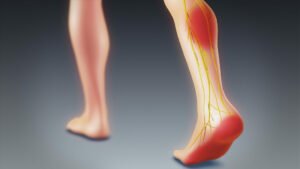Have you ever been stopped in your tracks by a sudden, shooting pain down your lower back and leg? If yes, then you might have had an encounter with the longest nerve in your body, the sciatic nerve. In this blog post, we delve deep into the realm of sciatica, a condition often surrounded by confusion and misconceptions. Our aim is to clarify the causes, symptoms, treatment options, and lifestyle modifications that can alleviate the pain and discomfort associated with this condition.
Contents
What Nerve Is Affected In Sciatica?
 Sciatica, a common type of pain affecting the sciatic nerve, occurs when this large nerve is irritated or compressed. The sciatic nerve is the longest and widest single nerve in the human body, running from the lower back through the buttocks and down the back of each leg. Specifically, it begins in the lower back at lumbar segment 3 (L3). It is formed from nerve roots that exit the spinal cord, merge together, and then travel down the back of the leg.
Sciatica, a common type of pain affecting the sciatic nerve, occurs when this large nerve is irritated or compressed. The sciatic nerve is the longest and widest single nerve in the human body, running from the lower back through the buttocks and down the back of each leg. Specifically, it begins in the lower back at lumbar segment 3 (L3). It is formed from nerve roots that exit the spinal cord, merge together, and then travel down the back of the leg.
When functioning normally, the sciatic nerve plays a crucial role in connecting the spinal cord with the leg and foot muscles, enabling movements and sensations. However, if the nerve is compressed, it can lead to sciatica. This condition is typically characterized by pain that radiates along the path of the sciatic nerve. And often felt in the lower back, buttock, and down the back of the leg.
What Are The Common Symptoms To Know?
Sciatica usually affects only one side of your body and the pain can be severe. This typically radiates along the path of the sciatic nerve. Here are some common symptoms:
- Lower Back Pain: Although sciatica originates in the lower back, the back pain can be less severe than the pain experienced in other areas affected by the nerve.
- Buttock and Leg Pain: The most distinctive sign of sciatica is pain that radiates from your lower (lumbar) spine to your buttock and down the back of your leg. This pain can take various forms—it can be sharp and searing, or dull and aching. And it might feel like an electric shock or jolt.
- Numbness, Tingling, and Muscle Weakness: You might experience numbness or a tingling sensation in the leg or foot on the affected side. Muscle weakness is also a common symptom. This can cause difficulty in moving or controlling the leg.
- Pain on Movement: The pain can become worse when you cough, sneeze, or sit for a long time. Similarly, sudden movements, like standing from a sitting position or twisting your body, might also increase the pain.
- Increased Pain Over Time: Typically, sciatica pain is mild initially but can become more intense over time.
- Foot Drop: In severe cases, you may experience a condition known as “foot drop,” where you have difficulty lifting your foot off the ground due to muscle weakness.
Remember, sciatica symptoms can be similar to symptoms of other medical conditions. So it’s important to get a proper diagnosis from a healthcare provider to ensure effective treatment.
What Triggers Sciatica Nerve Pain?
 Sciatica nerve pain is typically triggered when something presses on or irritates the sciatic nerve. Here are some common causes:
Sciatica nerve pain is typically triggered when something presses on or irritates the sciatic nerve. Here are some common causes:
- Lumbar Herniated Disc
Also known as a slipped disc or ruptured disc, this condition occurs when the soft inner material of the disc leaks out, or herniates, through the fibrous outer core and irritates the contiguous nerve root.
- Degenerative Disc Disease
Age-related changes in the discs of your spine may irritate a nerve root and cause sciatica.
- Spinal Stenosis
In some individuals, the spine narrows, compressing the nerves. This condition is common in adults over 60 and can cause sciatica.
- Spondylolisthesis
This condition happens when one vertebra slips forward over the one below it, narrowing the space through which the sciatic nerve exits, causing irritation or compression of the nerve.
- Piriformis Syndrome
The piriformis muscle starts at the lower spine and connects to the upper surface of each thighbone. If this muscle spasms or becomes tight, it can put pressure on the sciatic nerve, leading to sciatica-like pain.
- Pregnancy
The changes in the body, including weight gain, shifts in the center of gravity, and hormone changes, may cause inflammation and pressure on the sciatic nerve during pregnancy.
- Other Causes
In rare cases, the sciatic nerve can be compressed by a tumor or damaged by diseases such as diabetes.
It’s important to identify the specific cause of sciatica for effective treatment. If you’re experiencing persistent lower back and leg pain, seek medical attention promptly to prevent further complications.
How Can I Relieve Sciatic Nerve Pain?
Relief from sciatica nerve pain can often be achieved through a combination of self-care practices and medical treatments. Here are some strategies that may help:
Over-the-Counter Pain Relievers
Non-prescription medications such as ibuprofen (found in Advil, Motrin) and naproxen (Aleve) belong to a class of drugs known as non-steroidal anti-inflammatory drugs (NSAIDs). They work by reducing the body’s production of substances that cause inflammation and pain.
These can be the first line of defense in managing the pain of mild to moderate sciatica. It’s important to use these medications as directed on the package and to speak with a healthcare provider if the recommended dose isn’t bringing relief.
Physical Therapy
Physical therapy can play a crucial role in managing sciatica. A physical therapist will first conduct a thorough assessment of your condition, including your medical history, pain intensity, and pain behavior. Then, a personalized treatment plan will be developed, which often includes exercises that promote flexibility and strengthen muscles, particularly those in your abdomen and back, which are crucial supporters of your spine.
Posture training is also a key part of physical therapy. The therapist can show you how to sit, stand, and lift in a manner that keeps your spine properly aligned. The ultimate goal of physical therapy is not only to alleviate your current symptoms but also to equip you with knowledge and exercises that can prevent future sciatic flare-ups.
Heat and Cold Therapy
Applying a cold pack or a heating pad to the painful area can provide some immediate relief. Each works in a different way. Cold therapy can help reduce inflammation, a key cause of sciatica pain. It also helps numb the painful area, providing immediate relief. Heat therapy, on the other hand, stimulates blood flow to the area, which promotes healing and reduces muscle stiffness.
A general approach is to apply a cold pack to the area for the first few days (15 minutes every hour or so), then switch to heat. Some people find more relief with one method than the other, so you might want to experiment to see which works better for you.
Regular Exercise and Movement
When you’re in pain, your natural impulse might be to rest and avoid physical activity. But too much rest can lead to muscle weakness, which can exacerbate sciatica symptoms. Regular, gentle exercises can help by stimulating blood flow, improving flexibility, reducing inflammation, and strengthening the muscles that support your spine.
Walking is a good choice as it’s a low-impact exercise that can get your body moving without aggravating your symptoms. Swimming, yoga, and pilates can also be beneficial. It’s crucial to start slow and gradually increase the intensity and duration of your exercises, and always check with your doctor or a physical therapist before beginning a new exercise regimen.
Maintain Good Posture
Good posture involves training your body to stand, walk, sit, and lie in positions where the least strain is placed on your muscles and ligaments. While sitting, choose chairs with good lower back support, armrests, and a swivel base. Keep your knees and hips level and your feet on the floor. Avoid slumping or slouching, which puts extra pressure on the lower back and can irritate the sciatic nerve.
Sleep Positioning
How you sleep can either relieve or exacerbate sciatica symptoms. For some people, sleeping on their back with a pillow under their knees can help by maintaining the natural curve of the back and reducing pressure on the sciatic nerve. For others, especially those with a herniated disc, lying on the stomach may be beneficial. Using a firmer mattress can also help maintain proper spinal alignment during sleep.
Surgical and Other Procedures
 If conservative treatments don’t improve your symptoms after several weeks, your doctor may suggest other options. One possibility is a corticosteroid injection around the root of the nerve to suppress inflammation and help relieve sciatica. In some cases, especially when there’s significant weakness or loss of bowel or bladder control, surgery might be the best option. There are several types of surgery that can help, depending on the cause of the sciatica.
If conservative treatments don’t improve your symptoms after several weeks, your doctor may suggest other options. One possibility is a corticosteroid injection around the root of the nerve to suppress inflammation and help relieve sciatica. In some cases, especially when there’s significant weakness or loss of bowel or bladder control, surgery might be the best option. There are several types of surgery that can help, depending on the cause of the sciatica.
For example, a herniated disc might be treated with a discectomy, where the part of the disc pressing on the sciatic nerve is removed. It’s important to discuss all of the benefits and potential risks of these treatments with your doctor to make an informed decision.
Always consult your healthcare provider before starting a new medication or therapy, especially if you have underlying health conditions. They can provide a personalized treatment plan based on your symptoms and overall health.
Conclusion
In conclusion, while sciatica nerve can be a painful and disruptive condition, understanding its causes, and exploring diverse treatment options empowers you to take control. Whether it’s through conservative methods or more advanced treatments, relief from sciatic nerve pain is within reach. Remember, it’s crucial to consult with your healthcare provider to ensure an accurate diagnosis and tailored treatment plan.
Though the road to recovery may require patience, your efforts can lead to improved comfort, mobility, and overall quality of life. Stay proactive and positive on your journey towards health and well-being. If you’re experiencing Elbow pain, physical therapy for elbow pain at PhysioMantra can help: Book an online physical therapy session.



